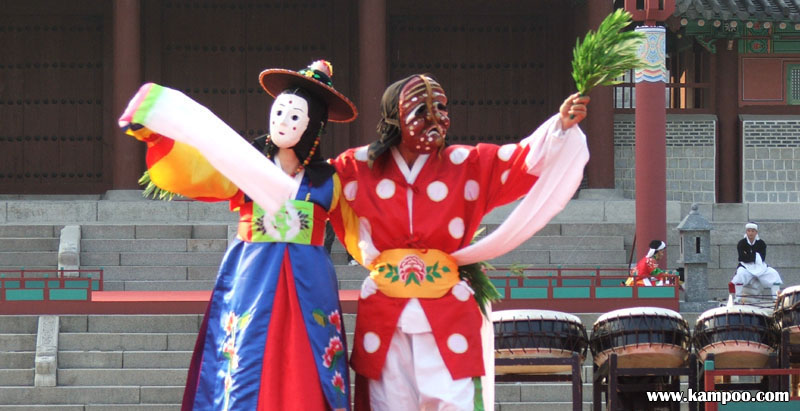康翎面踊り
(강령탈춤)
タルチュム(仮面舞)とは一人もしくは多くの人が仮面で顔や頭全体を覆い、他の人物や動物、または神などの超自然的な存在に扮装し、音楽に合わせて踊りながら台詞を語る演劇のことである。 タルチュムは朝鮮時代前期までは全国の各地方で行われた仮面舞であった。それが17世紀中頃になると宮中の管掌のもと、「山台」と呼ばれる舞台で披露された山台都監劇の一種として扱われた。 仁祖12年(1634)になると宮中での上演が廃止されたため、それが民衆に流れて全国に伝えられるようになった。
康翎タルチュムの内容の中で、両班3兄弟が出て両班としての根本的な姿を発見したり、マルトゥギを呼んだりマルトゥギが才知に富んだ話しをする過程は慶尚南道の五広大に似ており、お婆さん広大が糸車を回す場面は賀山五広大と非常に類似しているが、このような類似点はタルチュムの伝来において非常に重要な意味を持っている。 また、写実的な人の顔を描いた仮面を被り、長衫踊りを踊る上品で柔らかい姿は、同じ黄海道タルチュムである鳳山タルチュムとは異なる特徴である。
탈춤은 조선 전기까지 각 지방에서 행해지던 가면놀이이다. 17세기 중엽에 이르러 궁중의 관장하에 “산대”라 불리는 무대에서 상연되던 산대도감극(山臺都監劇)의 형태로, 인종 12년(1634)에 궁중에서의 상연이 폐지되자 민중에게 유입되어 전국으로 전파되었다. 황해도탈춤은 황해도의 평산과 기린의 남북을 중심으로 북쪽의 봉산탈춤형과 남쪽의 해주탈춤형으로 나눌 수 있는데, 강령탈춤은 해주탈춤형으로 분류된다.
강령탈춤은 매년 단오에 행해지는데 사자춤·말뚝이춤·목중춤·상좌춤·양반과 말뚝이춤·노승과 취발이춤·영감과 할미광대춤의 7개 과장으로 구성되어 있다. 놀이에 앞서 탈과 의상을 갖추고 음악을 울리면서 공연장소까지 행렬하는 길놀이를 한다. 등장인물은 마부·사자·원숭이·말뚝이·목중·상좌·맏양반·둘째양반·재물대감·도령·영감·할미·용산삼개집·취발이·노승·소무 등 모두 20명이다. 파계승에 대한 풍자와 양반계급에 대한 모욕, 일부처첩의 삼각관계와 서민의 생활상에 대해 다루고 있다. 춤은 느린 사위로 장삼소매를 고개 너머로 휘두르는 장삼춤이 주가 되며, 장단에는 도드리, 타령, 자진굿거리가 주로 쓰이지만 소리의 사설이 30여 가지나 되고 소리마다 장단이 특이하다.
강령탈춤의 내용 중에서 양반 3형제가 나와 양반의 근본을 찾고 말뚝이를 부르거나 말뚝이가 재담하는 과장은 경남의 오광대와 비슷하고, 할미광대가 물레를 돌리는 장면은 가산오광대와 매우 유사한데, 이러한 유사점은 탈춤의 전래에 있어서 매우 중요한 의미를 갖는다. 또한 사실적인 얼굴 모습을 묘사한 인물탈을 쓰고 장삼춤을 추는 아담하고 부드러운 점이 같은 황해도 탈춤인 봉산탈춤과 다른 특징이다.

Talchum (mask dance) was performed across the country up to the early Joseon Period (1392 – 1910). Gangnyeong Talchum (Mask Dance Drama of Gangneung) is a type of Sandae Dogamgeuk, which was performed at the Royal Palace. After the mask dance drama came to be no longer performed there by 1634 (the 12th year of King Injo’s reign), it was still enjoyed as a pastime by ordinary people. The Mask Dance Drama of Gangnyeong is performed on Dano (May 5 on the lunar calendar) in Gangnyeong-eup, Hwanghaenam-do, and dates perhaps from the late Joseon Period. The event is composed of seven acts, Lion Dance, Malttugi Dance, Mokjung Dance, Sangjwa Dance, Dance of the Nobleman and Malttugi, Dance of Chwibari and the Old Monk, and Dance of the Old Couple. Prior to the performance, the 20 members of the troupe march, playing music to entertain spectators along the road.
The play includes satire about such issues as nobles harassing commoners, depraved monks, and male chauvinism as shown in the custom of allowing a man to take plural wives. Dance movements are slow. The main dance is Jangsamchum (Long Sleeve Dance). The rhythms used are dodeuri, taryeong, and jajin gutgeori. Thirty-plus types of narration are used, each of them using its unique rhythm. The parts concerning three brothers of a noble family talking about the essentials of the noble class or calling Malttugi, or Malttugi’s gag are similar to those of Ogwangdae (Mask Dance Drama) of Gyeongnam-do. The scene of an old female clown turning a spinning wheel is similar to that of Ogwangdae of Gasan. These similarities have a very important significance in the handing-down of mask dance in the country. Performers wearing masks displaying realistic facial expressions and engaging in elegant and slow dancing movements are features of Gangnyeong Talchum, which distinguish it from Bongsan Talchum, another kind of mask dance performed in Hwanghae-do.
出所:韓国文化財庁
updated: 2023.10.2